
- ��Ӱֱ��
- Travel Packages
- Top Destination
-
Travel Attraction
By Category
Top Attraction

- Travel Agents
- Car Rentals
- Hotels
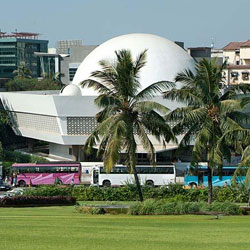
One of India finest architects J.M.Kadri designed this beautiful landmark building which houses Nehru Planetarium. Nehru Centre of Science is also located here. 8 Kms. from the city centre is located a centre telling about the universe. It unfolds the mysteries of the cosmos. They also screen regular film shows on the outer space, which are of particular interest for children. Close by is the Nehru Science centre, which is a science park, and permanent exhibits on intricacies of life. The antique models of Railway engines, aeroplanes, tramcar and steam lorry are exciting to see. Nehru Planetarium is the only astronomical centre in Mumbai, which is also a concert cum movie auditorium. This is the place, recreating the image of the sky as seen from anywhere on the earth at any time. It exhibits collections of lunar and astronomical photographs.
Explore More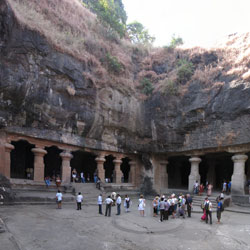
An interesting travel of about an hour by boat from the Gateway of India, passing the Mumbai harbour, and the Naval barges, takes you to Elephanta Caves where there are caves with carvings dedicated to Lord Siva. It is an UNESCO World Heritage site. The Elephanta Island is the site of the magnificent Elephanta caves, containing beautiful carvings, sculptures, and a temple to the Hindu God, Lord Shiva. The island of Elephanta, being a commercial, military and religions centre for centuries has traces of early Buddhist culture.One of the major Tourist ��Ӱֱ�� of Maharashtra, the Elephanta Caves are situated near the metropolitan city of Mumbai. The Elephanta island is located 10 Kms away from the Gateway of India. There are various rock cut temples present in these caves, which are as old as 5th century. The Elephanta Island was named by the Portuguese, after the statue of an elephant near the landing area of the island. Construction of The Caves : The rock cut temples in Elephanta Caves are carved out of rock. There are columns, internal spaces and images within these temples. The entire temple is related to a large sculpture. In fact one can walk through the corridors and chambers of this sculptured temple. Created through a process of rock removal, the entire complex is an interesting monument. Some of the rock surfaces here are finely finished whereas some are unfinished bare rock. The Elephanta rock caves are sprawled over a large area of about 60000 square feet. These temple caves consist of a main chamber, courtyards and several subsidiary shrines. There is also a mass of natural rock, above the temple. There are three entrances to the temple. The eastern and the western entrances mark the axis of the temple. There is a 20 pillared hall that lines the axis, and on its western end is a cell in which a Shivalingam enshrined. The Mystical Images : The magnificent image of Sadasiva, a manifestation of Shiva, is carved in relief at the end of the north south axis. The stupendous 20 feet high image of the three headed Shiva, known as Trimurthy is a magnificent one. It is regarded as a masterpiece of Indian art. This huge image represents Panchamukha Shiva, whose only three faces are carved into the wall. It attracts your attention just as you enter the temple through the northern entrance. Along with this image there are grand sculptured images of Kalyanasundara, Gangadhara, Ardhanariswara and Uma Maheswara on the southern wall. Other sculptured images of Nataraja and andhakaasuravadamoorthy are to the west of the northern entrance and the images of Yogiswara and Ravanaanugrahamurthy are to its east.
Explore More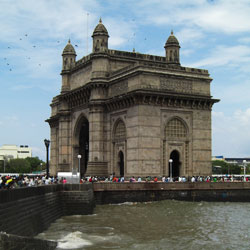
Gateway of India was built with yellow stone in Indo- Sarcenic style to commemorate the visit of King George V and Queen Mary to Bombay and since has become the Icon of Twentieth century Indian history. It is also remembered as the point from where the last British troops left the shores of independent India. To commemorate King George and Queen Mary's visit to India in 1911, the Gateway of India was built at Apollo Bunder, a popular meeting place. The Gateway was built by the British and designed by the architect George Wittet. The first stone was laid by the then Governor of Bombay on March 31st, 1913. This triumphal arch was built at an astonishing cost of 21 lakhs, and was open to the public in 1924. A conventional Arch of Triumph inspires its 26 metre high archway. It is complete with four turrets and intricate latticework carved into the yellow basalt stone. Ironically, when the British Raj ended in 1947, this colonial symbol also became a sort of epitaph: the last of the British ships that set sail for England left from the Gateway. Influences of the 16th century Gujarati style are also evident in its architecture. Situated next to the Taj Mahal Intercontinental Hotel, it is the most enduring landmark of Mumbai.
Explore More
Located in Worli the Nehru Science Museum with sound light gallery has an attractive childrens section. It is the only place, which recreates the image of sky as seen from anywhere on earth at any time. It also has a collection of warplanes, which served the Indian air force. Nehru planetarium was commissioned in 1977 and designed by one of India's finest architects I.M.Kadri. Nehru Centre, a trust headed by the Chief Minister of Maharashtra State, runs it. An astronomical exhibition, comprising of 40 exhibits (transparencies and working model) explain the cosmos. In the auditorium, a breathtaking 'Sky Show' captures the very essence of the Milky Way or Akashganga. Two hundred projectors are simultaneously trained onto a hemispherical ceiling made of aluminum. The effect is realistic and it is not surprising that the planetarium has attracted more than 3 million visitors.
Explore More
It opened in 1986 and now houses the Discovery of India exhibition, an art gallery, theatre and restaurant. Inspired by Nehru's book of the same name, it seeks to explore 5000 years of history by investigating the geographical, social, culture and political forces at play in the subcontinent. It's highly informative in a school trip kind of way. But then it's best to concentrate on just a couple of the major themes, such as the detailed exhibits depicting Nehru's life and times. Other interesting topics include the Mauryan Empire, the impact of the west and the struggle for independence. Children below five years of age not allowed into the Sky Theatre. The Nehru Planetarium is closed on Mondays. It was in 1972 that the Nehru Centre was conceived by the late Shri Rajni Patel and others as a living memorial to the maker of modern India, who symbolized the ideals of enlightened curiosity, scientific temper, secular values, a world view and above all, a faith in the people of India. The late Smt. Indira Gandhi laid the foundation stone of this magnificent dream on November 2, 1972 on a six-acre plot leased by the Government of Maharashtra.
Explore More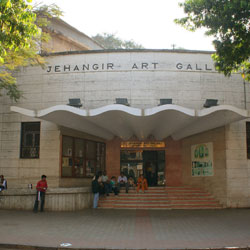
A prime art gallery in the city of Mumbai Jehangir Art Gallery caters to the artistic tastes of people. This is situated behind the museum and has four exhibition halls. Facing Elphistone College and adjacent to the Prince of Wales Museum, this gallery situated at Kala Ghoda is the most prestigious and modern venue for Indian artists. It was built in the year 1952. Managed by the Bombay Art Society, the entire cost of this beautiful mansion was donated by Cowasji Jehangir. This gallery is one of the city's most highly visible art galleries and having to exhibit a work of art here is a great treat for artists. The unending list of applicants to have their work put up on the walls of this gallery speak for itself of the great importance and the media attention one attracts. Some might have to wait a couple of years to have their work put up here.
Explore More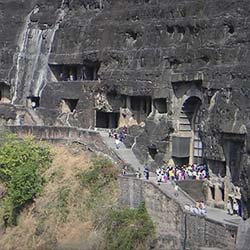
About Ajanta Caves History The Ajanta Caves, located in Aurangabad, India, are a set of 30 rock-cut Buddhist cave monuments dating back to the 2nd century BCE. These caves were abandoned in the 7th century and rediscovered in 1819 by a British officer named John Smith. The caves showcase ancient Indian art and architecture, depicting tales from the Jataka stories and the life of Buddha. Architecture and Design The Ajanta Caves are renowned for their intricate carvings, sculptures, and frescoes. The caves are carved out of solid rock and feature chaityas (prayer halls) and viharas (monasteries). The architecture reflects a blend of Buddhist and Hindu styles, with elaborate pillars, intricate ceilings, and detailed sculptures. Best Time to Visit The best time to visit the Ajanta Caves is during the cool and dry months of October to March. The weather during this time is pleasant, making it ideal for exploring the caves and enjoying the surrounding landscapes. Cultural Significance The Ajanta Caves hold immense cultural significance as they provide a glimpse into ancient Indian art, architecture, and religious beliefs. These caves are a UNESCO World Heritage Site and are considered a masterpiece of Buddhist religious art, showcasing the evolution of Indian art over centuries. Pilgrimage Practices Many visitors to the Ajanta Caves come on a pilgrimage to pay homage to Buddha and explore the spiritual significance of the caves. Pilgrims often engage in meditation, chanting, and offering prayers at the various shrines and stupas found within the caves. Dress Code and Etiquette Visitors are required to dress modestly when visiting the Ajanta Caves, as they are considered a sacred site. It is advisable to wear comfortable clothing that covers the shoulders and knees. Respectful behavior and quiet demeanor are expected inside the caves to maintain the sanctity of the place. Activities and Experiences Visitors to the Ajanta Caves can engage in a variety of activities and experiences, including guided tours, photography, and exploring the intricate details of the cave art. Many visitors also enjoy witnessing the mesmerizing light and sound shows that bring the history of the caves to life. Art and Religious Symbols The Ajanta Caves are adorned with stunning artworks, frescoes, and sculptures depicting various religious symbols and stories from Buddhist mythology. The art within the caves showcases intricate carvings of Buddha, Bodhisattvas, and scenes from the life of Buddha, illustrating the spiritual and artistic prowess of ancient India. Local Insights Local guides and historians often provide valuable insights into the history, significance, and artistry of the Ajanta Caves. Visitors can learn about the various cave structures, the symbolism behind the artwork, and the cultural context of the caves, enhancing their overall experience and understanding of this ancient site.
Explore More
George Wittet designed this Indo- Saracenic style building, which houses the Prince of Wales Museum. It also houses a priceless collection of art, sculpture, a fine collection of miniature paintings and much more. Amid the hustle and bustle of Mumbai stand some stately buildings, remnants of the British Raj. Among them is the Prince of Wales Museum, named after Prince George (Later George V) who visited India in 1905 and laid the foundation stone of the building. Through the arch the Prince made his royal entrance to India as King George V for the Delhi Darbar in 1911. This four-tiered goliath houses a priceless collection of over 2000 miniature paintings from various stylistic schools in India. Among other artifacts feature a sizeable number of relics of the Indus Valley Civilisation and instances of Tibetan and Nepalese art.
Explore More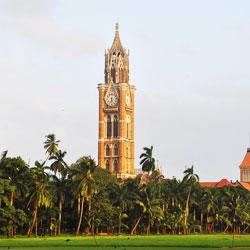
Located in the gardens of Mumbai University, Rajabai Clock Tower consists of 5 elaborately decorated storeys. The tower is 280 ft. in height commanding a fine view of the city. Next to the High Court, the Venetian -Gothic University has a Gothic clock tower that is curiously adorned with oriental figures. In the old days it used to play Rule Britannia, God Save the King and a Handel Symphony among sixteen tunes that changed four times a day; now the repertoire is limited to the wafting chimes of the Big Ben on the quarter hour. The Clock Tower is named after the mother of a 19th century stockbroker, who contributed towards its construction. It has a spiral staircase, which is unfortunately closed to the visitors after several unhappy citizens hurled themselves from the top. Under the clock tower is the magnificent University Library, with what are undoubtedly some of the most exquisite stained glass windows in Asia. These have recently been treated by British conservationists and restored to their pristine glory. Well worth a look. Architects who spent most of their working years in the city designed most buildings in Mumbai. The buildings of the University in the fort campus are the exception-- the English architect Sir Gilbert Scott designed them. The �Cotton King� and banker, Premchand Roychand, funded the library and the Rajabai clock tower, in memory of his mother Rajabai, with its marvelous sculpted figures. The convocation hall was funded by the man with the deepest pockets in Bombay-- Sir Cowasji Jehangir Readymoney. One of Mumbai's outstanding landmarks, the Rajabai Clock Tower is situated in the gardens of Mumbai University. Inspired by Giotto's Companile in Florence, Gilbert Scott planned the structure. It was completed in the 1870's.
Explore More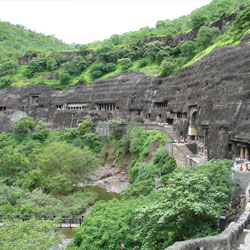
Just outside the city, are located the 6th century caves displaying the influence of Tantric cult in the iconography and architectural designs of the caves. A major chunk of the caves are viharas, of which Caves 3 and 7 are most fascinating. These were excavated between the 2nd and 6th century AD. Tantric influences can be discerned in their architecture and iconography. There are twelve caves in all, a major chunk of which are viharas, of which Caves 3 and 7, are the most fascinating. Cave 3 stands supported by 12 finely carved columns, and sports sculptures portraying scenes from the Jataka tales. Cave 7 houses an imposing sculpture of a Boddhisattva, praying for deliverance. Some of the chaitya halls here are constructed on a mandala plan for the circumambulation of the Buddha who is depicted here seated on an intricately carved throne. A short walk from Bibi-Ka-Maqbara is a set of caves slighted by their more glamorous neighbours, Ajanta and Ellora. The western group consists mainly of viharas (monasteries) and depictions from the Jataka tales. At the eastern group, there are sculptures of scantily clad buxom women in freaky hairdos, child-eating goddesses, musicians and dancers alongside images of the Buddha. This is indicative of the rise of Tantric Buddhism during the 6th and 7th century A.D. Nestled amidst the hills are 12 Buddhist caves probably dating back to the 1 A.D. One is also treated to a panoramic view of the city as well as the imposing Maqbara from this point. These caves are carved out of the hillside and are a fine piece of architecture, housing the most stunningly intricate carvings.
Explore More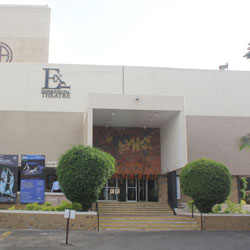
National Centre of Performing Arts
The National Center of Performing Arts was established in 1966 to preserve and promote India rich cultural heritage in classical and folk music, dance and drama. Apart from its traditional art schools, India also has a contemporary art lineage that began in the early fifties. While pioneers like MF Hussain and FN Souza spearheaded this modern art movement, Mumbai was the cradle of these brave new aesthetes. Today, contemporary Indian art is known to the world over, which can be viewed at the National Gallery of Modern Art bang opposite the Prince of Wales Museum. Converted from an old public hall, this dynamic, three tiered structure houses collections from India's best known living artists providing a convenient overview of the country's contemporary art scenario.
Explore More2 Day 1 Night Pune To Tuljapur Akkalkot Pandharpur
2 Days/ 1 Night
Pune
5 Night - 6 Days Maharashtra 5 Jyotirlinga Darshan Tour
6 Days/ 5 Night
Aurangabad - Pune - Shirdi - Trimbakeshwar - Shani Shingnapur - Hingoli - Beed
Grand India Tour 29 Days
29 Days/ 28 Night
New Delhi - Jaipur - Jaisalmer - Jodhpur - Ranthambore - Udaipur - Agra - Varanasi - Kochi - Alleppey - Khajuraho - Mumbai - Orchha - Munnar - Goa City
Mumbai - Aurangabad - Ajanta - Ellora 6 Nights 7 Days Tour
7 Days/ 6 Night
Aurangabad - Mumbai

Parts of World Heritage monuments are the Ellora Caves located at about 400 kms from Mumbai. These cave monuments were patronized by Chalukya kings during 17th Century. The creative dynamism of the artists can been seen from the sculptures where they drew themes from the Hindu mythology and transformed the rocks into a cavalcade of God and Goddesses. The Ellora Caves lay in the lap of the Chamadari hills extending over a mile and a quarter in the north-south direction. They are situated 18 miles northwest of Aurangabad. Ellora represents some three hundred years of great experiments carried out by different faiths with their very different iconography and structural compulsions. Ellora first appears to the visitors as an irregular ridge of rock, rising vertically from the ground.
Explore More
Cursetjee Fardoonjee Parekh donated this landmark structure Flora Fountain. Built in 1864, it was made of imported Poland stone and is located close to the church gate of the old (now vanished) British fort. Flora is the Roman Goddess of Flowers, her pretty alabaster face continually assaulted by grime and pollution. It stands at a busy five-point intersection in the heart of the commercial Fort area. The Flora Fountain was erected by the Agri-Horticultural society of Western India. It was originally meant to be named after Sir Bartle Frere, then governor of Bombay. However, the name was changed before the fountain was unveiled. It stood in the center of the town as it then was, but now this area is the heart of the business district of the town. This is the very heart of Mumbai, circumscribed by stately colonial buildings standing like proud old sentinels of a bygone era. Next to her are a pair of torch bearing stone patriots that rise from the Martyrs Memorial nearby. Flora Fountain is now called Hutatma Chowk or Martyr's Square to honour those who died in the tumultuous birth of Maharashtra State. All around the square sit Mumbai's infamous vendors selling just about everything under the blazing tropical sun - from cheap nylon saris to herbal remedies. Tooting horns and traffic complete the chaotic picture, but through it all Flora manages to retain her serene composure.
Explore More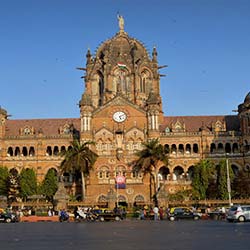
Opened on the New Year Day in 1882, this Gothic building housing the main railway station of Mumbai was designed by F.W.Stevens and was named after the then Queen Empress on Jubilee day in 1887. It is also declared as an urban heritage site. It was renamed as Chatrapathi Sivaji terminus in 1996 after addition of an underground suburban terminus. Presently, the headquarters of the Central Railway, this magnificent terminus building, commonly known as CST, was completed in 1888 for the Great Indian Peninsular Railway. It is one of the world's grandest railway stations, quite the equal of New York's Grand Central Station or London's St Pancras Station. It looks more like a cathedral than a railway station, an impression strengthened by the tall dome crowned with a statue representing 'Progress'.
Explore More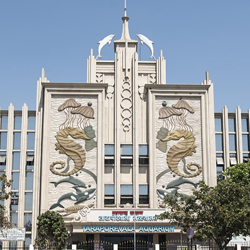
Mumbai is the financial city of the country. There are many places that you can visit while you are in the city. Among many other famous attractions, Taraporewala Aquarium, Mumbai is the oldest and the most famous. Located in the popular Marine Drive in the city, the aquarium has many marine and freshwater fishes. History of the Aquarium Taraporewala Aquarium, Mumbai was built in 1951 with the help of DB Taraporewala, a Parsee philanthropist, who donated a huge amount for the aquarium. It was inaugurated by India’s first president of India, Rajendra Prasad. It was renovated and reopened in 2015 and has glass aquariums all over. It houses more than 100 species of marine life such as fishes, stingrays, turtles, etc. Some of these marine lives are found only in Lakshadweep island. The place also has fossils that show the evolution of fishes. The aquarium is maintained by the Department of Fisheries. It has around 16 seawater and 9 freshwater, and 54 tropical tanks. The tropical section of the aquarium has different ecosystems like plantation, moss, island, etc. What will you See in the Aquarium? At the Taraporewala Aquarium, Mumbai you will find many freshwater and marine fishes that look beautiful. There is an acrylic glass tunnel that is around 12 feet long. There is a pool where you can touch the fishes and enjoy your visit. The beautiful fishes in the aquarium can leave you spellbound. What are Popular ��Ӱֱ�� Here? When you enter the Taraporewala Aquarium, Mumbai, you will find oceanarium with a variety of fishes. There is also an amphitheatre with seating for around 50 people. The touch pool is the favourite place for children who are visiting this place. If you are tired of walking around the city and visiting this place, then enjoy a fish spa to rejuvenate yourself. The touch pool has more than 350 species of fishes. It is a wonderful place for children to learn and educate themselves. The aquarium is a perfect place to spend a day’s picnic. Different Species of Fishes in the Aquarium There are hundreds of species of fishes that you can enjoy in the Taraporewala Aquarium, Mumbai. You can witness Damselfishes such as moon tail, golden damselfish, striped, sergeant major damsel, cocoa, and electric blue. You see some tropical fishes, sucker, red tail, and Asiatic catafishes. If you think this is all that is there to see, then you can find different kinds of marine eels to amaze your eyes. Amaze yourself with a variety of butterflyfishes, triggerfishes, angelfishes, tangs, etc. You can also touch sea urchins, sea cucumber, tube worms, brittle star, starfish, etc. Other than these species, you can enjoy viewing batfish, golden travery, jelly fishes, dwarf lion, squirrel fish, negro, arowana, marine coral reef, whimple, etc. You will also enjoy witnessing alligators, octopuses, goldfish, sea turtles, seahorses, koi, red-earned sliders, etc. What is the Right Time to Visit the Aquarium? The best time to visit the aquarium is when the weather is nice. Even though it is indoor, the weather in the city can be harsh during summers. Except for Mondays, when the aquarium is closed, you can visit it from 10 am – 8 pm with a one-hour break from 1 pm – 2 pm. There is also a nominal fee for everyone. However, entry fees vary for children and adults. Also, you would need to pay additional charges for taking photos. How to Reach the Museum in Mumbai? You can reach the museum by train, bus, or taxi. The nearest train station is Charni road or Churchgate. You can then take a taxi or bus to reach the museum from either of the train stations.
Explore More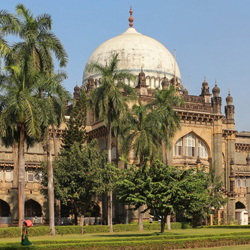
Traveling to Mumbai can be fun as the city has many beautiful beaches and attractions that can awe you. The nightlife of the city is very well known to people across the country. The people of the city are also known to be big foodies and hence, you will not be disappointed with the city when it comes to cuisines. However, the city also likes to keep its heritage and art preserved for people to see. Chhatrapati Shivaji Maharaj Vastu Sangrahalaya, Mumbai(CSMVS) is one such place that holdsart and cultural heritage. The museum was previously known as the Prince of Wales Museum of Western India. It has won awards for Heritage Building Maintenance by the Indian Heritage Society and the '2010 UNESCO Asia – Pacific Heritage Award' for Cultural Heritage Conservation. History of the CSMVS In the year 1905, a number of well-known people got together and decided on erecting a memorial for the Prince of Wales visit to the city. This led to the laying of the foundation stone by the Prince of Wales towards the end of 1905. The museum was then named Prince of Wales Museum of Western India. The building for the museum got completed in 1914. However, it was only opened to the public in 1922. From the years 1914 to 1922, the building was used as a military hospital and Children’s Welfare Exhibitions. Around the year 1998, the name of the museum was changed and now it is famously known as Chhatrapati Shivaji Maharaj Vastu Sangrahalaya, Mumbai. The building of the museum has been built in Indo-Saracenic style designed by the architect, George Wittet. It is built with buff-coloured trachyte Malad stone and Kurla basalt stone. The interiors of the museum reflect an 18th century Maratha mansion. It houses around 50,000 artefacts consisting of miniature paintings, excavated artefacts, European paintings, ancient statues, etc. What to Expect Inside the Museum? The Chhatrapati Shivaji Maharaj Vastu Sangrahalaya, Mumbai is known to have a huge collection of ancient Indian artefacts. You can also find some of the best miniature paintings from across the country. You can get awed by the amazing collection of decorative art objects in textiles, jade, ivory, wood, metal, etc. The museum also houses artefacts from Nepal and Tibet which show religious and artistic importance or heritage. The museum also houses a Numismatic collection that displays important issues and matters over a period of time. If you thought this is all, then you will be amazed to see a huge collection of Japanese and Chinese porcelain, embroidery, metal, and ivory objects. As part of the art collection, the museum also houses European oil paintings and Indian armours and arms. There are many artefacts that have been excavated in the country and outside the country too. Some of these artefacts have been excavated by the renowned archaeologist, Henry Cousens. Many well-known personalities contributed to the collection of the artefacts that are displayed today. Enjoy the CSMVS Children's Museum Chhatrapati Shivaji Maharaj Vastu Sangrahalaya, Mumbai has something for everyone, and this includes the children too. The museum has a museum and creative space for children where they can learn and get creative. The open space in this part of the museum helps the children to get creative, learn through various kinds of exhibitions, workshops, activities, etc. The museum displays exhibit the work of various young curators to encourage them to grow. The museum also has competitions for budding artists. The children can enjoy the tour of various interesting exhibits. They can also enjoy the interactive activities offered by the museum such as drawing and painting of animals and masks, puzzles, games, etc. Kids can also start their own panchayat class where they will be given problems that they have to solve. For a child who loves reading, the museum also offers them a wide collection of books and a peaceful corner for them to read. When to Visit the Museum Chhatrapati Shivaji Maharaj Vastu Sangrahalaya, Mumbai is a great place to visit with family, children, and also for tourists. The museum is open the whole week from 10.15 am – 6.00 pm. The museum has a nominal entry fee for children and adults. Students and senior citizens can get discounts on showing their id cards. If you want to take pictures inside the museum, then you will need to pay a little extra. Even though you are allowed to carry tripods inside the museum, selfie sticks are not allowed. How to Reach the Museum? The nearest terminuses to the museum are Churchgate and Chhatrapati Shivaji Terminus. They are around 20 minutes walk from the museum. If you do not feel like walking to the museum, then you can take an auto-rickshaw or a taxi. There are also some public buses that ply on the route. Tips for Visitors to CSMVS If you are planning to visit the museum, then be prepared to spend a few hours exploring it. The museum offers floor plans at all the floors that can help you in guiding your way to the exhibitions. It is a visitor-friendly museum that has lifts for people who are not able to climb stairs. You can also ask for wheelchairs from the museum’s Information Desk. The museum has a collection in Braille to help the visually impaired to enjoy the exhibits. There are special tours that are organised by the museum for visually impaired. If you are carrying too many bags with you, then you can leave it at the baggage counter in the museum. It also has an audio guide at a nominal price. You can choose guided tours by choosing to contact the authorities in the museum in advance. However, these tours need to have at least 25 people in a group. If you are hungry during your tour of the museum, then they have a café where you can enjoy some snacks and beverages.
Explore More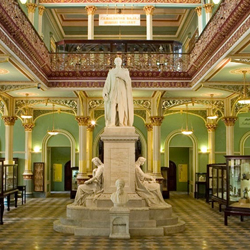
As the oldest museum in the city Dr. Bhau Daji lad museum, Mumbai was established in the year 1855. The museum reflects the city rich history and cultural heritage with its rare collection of decorative Art which showcases the craftsmanship of different communities of the city presidency. The museum also demonstrates the city history beginning from the twentieth century with its collection of rare books documenting the life of people living in the city at the time, photographs, maps, clay models, etc. Traveler tips The museum is open every day except for Wednesday from 10:00 am to 6:00 pm. Apart from this, the museum is also closed on public holidays. The entry fee for Indian residents visiting the museum is rupees 10 for adults and rupees 5 for small children while for foreigners the entry fee is rupee 100. To thoroughly explore the museum tourists require at least 2 to 3 hours in hand exploring the place to the fullest. While the museum is wheelchair user friendly however photography is not allowed on the campus. Registering on the official site will help the tourist to understand the details of the museum along with upcoming events and also allow easy access to the museum. Things to do There are tons of activities which both the adults and kids can enjoy simultaneously, children activities include workshops, and treasure hunts, etc as for adults various educational lectures on history, arts, educational programs on music, films, etc are available. One can even explore nearby cafes, restaurants, bookstores, etc too for fun-filled trips to the museum. Availability Dr. Bhau Daji lad museum, Mumbai offers tour guides both for public and private tours. The tour guides are experts in several languages like Hindi, English, and Marathi, etc thereby catering to different age groups. The museum also offers audio guides for tourists. History The museum was first opened for public viewing in the year 1872.Dr. George Birdwood led the team of the fundraiser and conceptualized the design element of the museum with Dr. Bhau Daji after whom the museum is renamed in the year 1975. The museum committee had members from all different religions and was built in the honor of Queen Victoria. The museum was closed for full five years due to its revamping by INTACH. Architecture Since Dr. Bhau Daji lad museum, Mumbai is the oldest museum and its architecture is that of the British era. The museum also received a UNESCO Asia Pacific Heritage award of excellence for heritage conservation. It is the city's oldest museum but it also reminds of the architecture of the 19th century. The main hall of the museum is the double-height volume where galleries are placed. The Statue of Albert is placed in the central hall which showcases a collection of Indian arts and crafts along with other art and crafts famous in Europe then. Festival There are lots of festivals celebrated in Mumbai but Ganesh Puja is famous and it is celebrated with great enthusiasm. Diwali and Janmashtami also celebrated with great joy. Best time to visit Since Dr. Bhau Daji lad museum, Mumbai is open all through the year and fully air-conditioned tourists can visit the museum anytime. However for a unique traveling experience, one can visit the museum during certain events hosted by the museum for a memorable trip. How to reach The museum is well connected with rail and road with both Mahalaskmi and Byculla railway station being nearby. There are also tons of buses available that frequent to the museum at regular intervals. Interesting facts and trivia about The museum has won a UNESCO Award in the year 2005 for excellence in heritage conversation. Another interesting facet of the museum includes that the quixotic design in the museum roof is named after Jewish patron David Sassoon and is known as’ star of David ‘. The museum was earlier known as Victoria and Albert Museum. FAQ Before visiting the museum one must keep in mind the timings of the museum and also make sure those belongings of the museum should not be damaged. Thus visit this beautiful place Dr. Bhau Daji lad museum, Mumbai, when you are, happens to be at Mumbai.
Explore More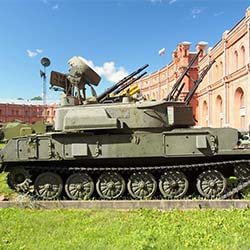
The Artillery Museum in Nashik is the biggest artillery museum in not just Maharashtra or India but Asia as well. It was relocated to India during the India-Pakistan partition. It is spread across 2 floors and is considered one of the best artillery centers in India for training the pupils of the Indian Army. On display in this museum are a number of vintage and modern weapons that offer a sight to behold to all the visitors. It is located behind the hills of the beautiful Pandavleni caves and on the foothills of the Sahyadri Mountain Range. This beautiful location makes it an even more appealing tourist spot. Bofors guns, cannons, tanks, military agreements, and different paintings and pictures of historical events are also showcased in this museum. It Is Known For:-1) The humongous size and the countless modern as well as vintage weapons that it has on display.2) The beautiful location that is right on the foothills of the Sahyadri Mountain Range and behind the Pandavleni caves.3) The photographs and paintings of the memorable historical events that took place in the history of India-Pakistan partition.4) The AOP and the MIG-23UM aircrafts that are on display also attract many tourists.Best Time To Visit:-The months from October to March are great with respect to the weather of the city as these are cool months when you can easily stroll through the city and enjoy your time. The national holidays and other special days like Army day etc., are also a great time to plan a visit to this artillery museum to see special preparations.Reaching There:-Reaching the Artillery Museum in Nashik is very easy owing to its location in Deolali Gaon in Nashik. It is easily connected by the road and local transport and buses can take you here.Nearest Airport:- Ozar AirportNearest Railway Station:- Nashik Road Railway Station
Explore More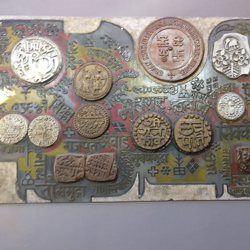
Coin Museum is one of the renowned museums in Nashik, Maharashtra in India. The museum has a fine collection of coins that portray the research and well-documented history of Indian currencies. This museum is the only museum of its kind in Asia constructed in 1980 underneath the Indian Institute of Research in Numismatic Studies. The environment of the museum is very cool and calm, as it is situated in the backdrop of the fascinating Ajneri Hill of Nashik History The coin museum was constructed to convey a universal idea about Indian coins to the common people. Coin museum provides an immense idea of the Indian coinage from the most primitive period to the present times with the support of coins, moulds, dyes, imitations, photos, and transitory write-ups. Not just the casting and machine are outstanding, but the museum also displays dioramas of depicting coin casting and coin manufacturing systems. You will also come across with numismatic material like bronze, terracotta\'s, copper-hoard stuff, canvases and some other historical articles as displayed there beautifully. This campus extends over an area of 505 acres of land. However, the wonderful weather here is due to the surrounding Anjaneri hills. When to Visit? As the museum is set at a wonderful place surrounded by Anjaneri hills, you can visit the place in every season. Temperature remains moderate throughout the year. Tourist attractions in Nashik If you are planning for a visit to Nashik then you must be aware of attractive tourist spots here, apart from coin museum. Panchvati It is a peaceful town set near Nasik. This place offers small sightseeing which would let you have a glimpse of the ancient world where the exile of Lord Ram, Sita and Laxman took place. There are banyan trees all around and the place is filled with an air of spirituality. Sula Vineyards This vineyard is an Indian winery situated in Nashik in India and the valley's first commercial winery. It also has been awarded a silver medal for its 2012 Sauvignon Blanc is the leading winemaker in India. The vineyard houses a resort to live in the middle of the winery along with a tasting room. This is the place where people can taste different wine samples with some exclusive varieties produced at the winery. Dudhsagar falls As far as the view is concerned, this is considered as one of the best falls. Dhudsagar falls deliver a panoramic view with remarkable scenery. This cascade is in full vitality during the rainy season and moderately a wonderful sight to observe. Saptashrungi Located on a hill range that includes seven hills, Saptashrungi is a place of religious consequence for Hindus. The determination to the temple is reasonably picturesque, especially throughout the heavy rain season. Trimbakeshwar Located at the source of river Godavari Trimbakeshwar is about 38 km away from Nashik. Suspended on the highest peak of Brahmagiri hills, Trimbakeshwar treasures one of the 12 Jyotirlingas of Deity Shiva in India. At first, there were supposedly 64 jyotirlingas among them 12 remains and are considered to be divine. Every site with one of the twelve jyotirlingas takes the name of the leading deity. Every single piece of the sacred shrine is considered to be a different manifestation of Shiva. Nashik caves Pandu Leni is also recognized as Nashik Caves. These are a group of 24 caves carved between the 3rd century BC and the 2nd century AD. These caves are representing the Hinayana Buddhist principles. Out of these 24 caves, two caves prominently the centre of attraction. The numerous engravings on the caves express that all the three kings that ruled Nashik at that time, specifically, the Satavahanas, the Kshatrapas, and the Abhirs fully reinforced Buddhism; however, they were not Buddhists in the real logic. Anjaneri Hills Anjaneri is known as the birthplace of Lord Hanuman and this place derived its name from Hanuman's mother Anjani. Hovering in the picturesque mountain range of Nashik-Trimbakeshwar, Anjaneri fort is situated at a distance of 20 km from Nashik. Kapileshwar temple One of the primogenital illustrations of this pilgrim city is that the place is a Shiva temple surrounded by an indication of secret due to the absence of a sculpture of Nandi Bull, usually originated in all Shiva Temples. this is one of the most frequented temples close to the Kalaram temple, in Nashik. Jain temple A fresh addition to the sacred places in Nasik is a straggling and elegant structure, the Jain Temple. The structure consists of three storeys and is constructed mainly in white limestone and pink sand. One can view the magnificent statues of 12-ton heavy deity of the 24th of Tirthankara of the Jains. Gangapur dam Gangapur Dam is an excavated dam on River Godavari. It is also famous as the longest clay reservoir in Asia. People come here to pass a peaceable afternoon on the garden by the river, adoring the wonderful, attractive backdrop of the river, straight out of a dream. One can also spot migratory birds in the evening, and there is a new boating capacity to entice more travellers. Kumbh Mela Nashik The mass Hindu sacred trip of Kumbh Mela includes gathering in a massive number here. The purpose of Hinduism followers is to bathe in a sacred river. Dhodap trek Dhodap is a wonderful trek to the fort in Maharashtra. Being one of the many forts at a height in the district of Nasik, it is situated at an altitude of about 4700 feet from the ground. Hence, it gives an exhilarating experience to fun lovers. Various treks are there to explore for trekking enthusiasts. How to Reach? Distance from Nashik CBS Bus Station is 19 Kms which can easily be covered by bus or cab. Visiting Hours: 9.30 morning- 1.00 afternoon and 2.00 afternoon - 5.30 evening It is closed on Sundays and all official holidays. Make a plan to visit this place by booking tour package to Nashik online.
Explore More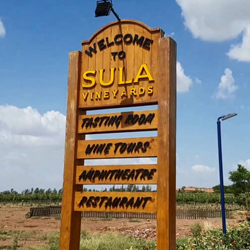
The Sula Vineyards is a famous winery of India. It is located in Nashik, 180 km to the northeast of Mumbai. This is the leading winery of India renowned for its assortments of grape wines, such as Chenin Blanc, Riesling, Zinfandel and Sauvignon Blanc. Considering the environment, this place is an ideal getaway for people who are tired of routine life and wish to spend their weekend or day off in relaxation, away from the commotion of the city. The atmosphere and surroundings of this winery are so wonderful that the visitors do not even realize they are actually in India. The picturesque views makeover them into a different world altogether. History of Sula Vineyard The Sula Vineyards was originated by Mr Rajeev Samant in 1998 who quit his commercial job in foreign just to come back to India. After his return, he established Sula vineyard. What trailed were researches with a variety of yields like teakwood, mangoes, roses and table grapes. Keeping in mind the country's seasonal conditions and temperature, finally, it was determined that wine grapes were the superlative crop to grow in India. Further, he took final consultation from Kerry Damskey, a Californian winemaker. And finally, Samant set up his first winery in Nashik- Sula Vineyard. Sula came from Samants' mother's name-Sulabha. With time newer varieties of grapes introduced, and the company extended its product assortment and collection. Now, Nashik is known as the Wine Capital of India that houses around sixty different wineries. Architecture From its establishment, the company started from a just 30-acre estate in Nashik. However, it has now stretched to around 1800 acres range across Nashik and Karnataka. This large estate is available to visit by the common public for a tour of wine tasting and roaming into the vineyard on all days throughout the year. This is why it has become a famous tourist spot and has gained immense popularity over the years. Availability Sula Vineyards house approximately sixty wineries and brags the title of being the first-ever winery in the entire nation. The Grape Trudging fun activity that takes place between January and March is a furthermore delight to the visitors here. The vineyard also consists of two restaurants that serve mouthwatering food, a gift shop and a bottle shop. The vineyards also house a resort to live in, a winery, and a tasting room where people can sit and taste different samples and varieties of wines produced at the winery. How to Reach Sula Vineyard? Nashik is reachable by all means of transport from nearby states. It is around 180 km from Mumbai and 210 km from Pune. Festivals celebrated 1. Grapes stomping The reaping and crushing season usually falls between January and March, hence, the perfect time for arranging and conducting grape stomping as a fest. Grape stomping is a Roman tradition including the crushing of grapes with one's bare feet. One can simply enjoy as it is an experience that you absolutely should not miss. 2. Sula fest A live music festival is also arranged at the vineyards, which is known as SulaFest. It takes place every year at the winery. This is a two-day epicurean world music festival which started in 2008. It offers its guests some incredible food and drinks with memorable music. Tourists who pay a visit during this festival can engage themselves in grape stomping, wine tasting and camping at the same festival. Tips For Visiting Sula Vineyard 1. The Sula vineyards is a major wine tourism destination. This is the reason for a huge influx of visitors and wine lovers during weekends and vacations. It is consequently recommended to visit this amazing place of attraction on weekdays for a peaceable and tranquil experience at the vineyards. 2. A tourist has to pay INR 37 for the Taste and Buy Package. This includes the expedition only which is an exclusive tasting of six wines with the Sula Winemakers. 3. If you are a wine lover then sign up for VIP tasting or customized premium tasting in small groups. This is the way to make the most out of your holiday. Nearby places to visit in Nashik When to Visit? You can visit the place every season due to its beautiful, serene and cool environment. The temperature remains moderate throughout the year. Tourist attractions in Nashik If you are planning for a visit to Sula Vineyards in Nashik then you must be aware of attractive tourist spots here. Panchvati It is a peaceful town set near Nasik. This place offers sightseeing which would let you have a glimpse of the ancient world where the exile of Lord Ram, Sita and Laxman took place. Dudhsagar falls As far as the view is concerned, this is considered as one of the best falls. Dhudsagar falls deliver a panoramic view with remarkable scenery. This cascade is during the rainy season and moderately a wonderful sight to observe. Saptashrungi Located on a hill range that includes seven hills, Saptashrungi is a place of religious consequence for Hindus. Trimbakeshwar Located at the source of river Godavari Trimbakeshwar is about 38 km away from Nashik. Suspended on the highest peak of Brahmagiri hills, Trimbakeshwar treasures one of the 12 Jyotirlingas of Deity Shiva in India. Nashik caves These are a group of 24 caves carved between the 3rd century BC and the 2nd century AD. These caves are representing the Hinayana Buddhist principles. Out of these 24 caves, two caves prominently the centre of attraction. The numerous engravings on the caves express that all the three kings that ruled Nashik at that time, were not Buddhists in the real logic. Anjaneri Hills Anjaneri is known as the birthplace of Lord Hanuman and this place derived its name from Hanuman's mother Anjani. Hovering in the picturesque mountain range of Nashik-Trimbakeshwar, Anjaneri fort is situated at a distance of 20 km from Nashik. Book Nashik tour package to include every enthralling tourist spot of Nashik in your vacation. Online travel agents can help you get the best deals.
Explore More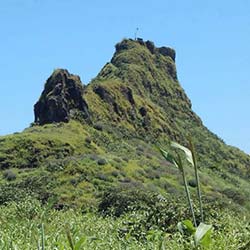
About The Tunga Fort The Tunga Fort, also known as Kathingad Fort, is located near Pune in the state of Maharashtra, India. Situated at an altitude of 1075 meters above sea level, this ancient fort offers breathtaking views of the surrounding landscape. Built by the Adil Shah dynasty, the fort is a popular trekking destination for adventure enthusiasts and history buffs alike. Timings Of Tunga Fort The Tunga Fort is open for visitors from sunrise to sunset on all days of the week. Entry Fee There is no entry fee to visit the Tunga Fort. However, visitors may need to pay a nominal fee for parking their vehicles at the base of the fort. Required Time And Restricted Items It takes about 2-3 hours to explore the Tunga Fort thoroughly. Visitors are advised not to carry any plastic items, alcohol, or tobacco products to maintain the sanctity of the historical site. Architecture Of Tunga Fort The Tunga Fort showcases a blend of Maratha and Mughal architectural styles. The fort is surrounded by lush greenery and offers panoramic views of the Sahyadri mountain range. The structure consists of sturdy walls, bastions, and intricate carvings that reflect the rich history of the region. Best Time To Visit The ideal time to visit the Tunga Fort is during the winter months of October to March when the weather is pleasant for trekking and sightseeing. Avoid visiting during the monsoon season as the trails may become slippery and dangerous. How To Reach The Tunga Fort is located approximately 50 kilometers from Pune city. Visitors can hire a private vehicle or take a local bus to reach the base of the fort. From there, it is a moderate trek to the top of the fort, which takes around 1-2 hours. History Of Tunga Fort The Tunga Fort dates back to the 17th century when it was built by the Adil Shah dynasty to serve as a strategic outpost. Over the centuries, the fort has changed hands multiple times and witnessed various battles between different rulers. Today, it stands as a symbol of the region's rich historical past. Inside Tunga Fort Inside the Tunga Fort, visitors can explore the remnants of ancient structures, including a mosque, a temple, and a water reservoir. The fort offers stunning views of the surrounding landscape, making it an ideal spot for photography enthusiasts. Traveling Tips 1. Wear comfortable trekking shoes and carry an ample supply of water. 2. Follow the designated trekking trails and avoid straying off the path. 3. Respect the local customs and traditions while visiting the fort. 4. Carry a camera to capture the scenic beauty of the fort and its surroundings. Hotels Near Tunga Fort With Names 1. Hotel Hill Top: Located near the Tunga Fort, this hotel offers comfortable accommodation and modern amenities for visitors. 2. Tunga Fort Resort: A luxury resort situated in the vicinity of the fort, offering a relaxing stay amidst nature's beauty. 3. Fort View Hotel: This budget-friendly hotel provides convenient lodging options for travelers exploring the Tunga Fort. Nearby Tourist Spots Of Tunga Fort 1. Lohagad Fort: Another historical fort located nearby, offering stunning views and a glimpse into the region's past. 2. Visapur Fort: A twin fort of Lohagad, known for its architectural marvels and scenic beauty. 3. Bhaja Caves: Ancient rock-cut caves that showcase intricate carvings and sculptures, located in close proximity to the Tunga Fort.
Explore More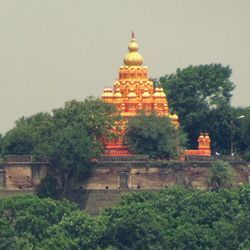
Parvati Hill, Pune came into existence with the help of famous Peshwa ruler Balaji Baji Rao in the 17th century. This place is located at 640 meters higher than sea level at the Parvati hillock in the south of the city in the state of Maharashtra. The one single top which is at the height of 260 metres above sea level is beautiful and good for site seeing. The view is extraordinary throughout the year and the climate over here is generally pleasant. The hill is also famous for its devotionals shrines dedicated to various Hindu God and goddesses like Lord Vishnu, Lord Devdeveshwar, Kartikeya, Lord Vinayakar, Goddess Rukmini, Lord Vitthalla and many more. If you are searching for a place to spend your weekend away from the hustle and bustle of your city, this place is the ideal place for you to spend your holidays. Traveller Tips When you visit a place for the first time, you as a visitor need to know the rules and regulations that should be followed to avoid any problem. Here are some that will help you when you visit Parvati Hill, Pune. • There are hardly any food stores nearby and you might face trouble finding food which is why you need to take a water bottle and some snacks along with you. • Be prepared because you will not get any hygienic washrooms nearby. • If you are a non-active person it might be a problem for you to climb 103 steps to reach the temple above the hill. • Take care of all you belonging and things that you carry. Keep most of them in your vehicle or car. That way it will be safe. • If you are aged and senior citizen it might be difficult for you to reach the top of the hill so better to take precautions beforehand. • The temple doesn’t have their parking for the visitors and tourists, so you need to park your car and vehicles a bit away from the premises that fall under the temple. • If you do not prefer a crowd, it is better than you avoid to go on state holidays as the place becomes crowded. • The surrounding needs to be maintained a bit more and should be cleaned properly but it is not so clean therefore you should not litter and make it worse. Things To Do • Get spiritually connected to the well-maintained and beautiful temple. • Visit the museum nearby known as the Peshwa Museum if you want to understand the amazing history that exists. • Plan your weekend trip to Parvati Hill, Pune with your friends and family and get mesmerised by the beautiful panoramic view that the hill provides you of the city Pune from the top of the hill. • If you are an atheist and don’t believe in visiting the temple, you can surely come here for your morning jogs and climb up the 103 stairs daily and get fit. • Love photography or being clicked, come here and get beautiful profile pictures. Availability There are no available guides for you and the hill has different interpretations for different people. The government should pay more attendance to the maintained subject. Best Time To Visit The place provides you with beautiful and outstanding views and the weather is good to go throughout the year still the months of August to February are exceptionally pleasing. How To Reach? You can reach to Pune via railway or road. The nearest airport is the Pune airport and the nearest railway again is the Pune railway station. Then you can go to the bus station that is near to the station and then reach the Parvati hill. Regular buses are available along with auto-rickshaw. Choose the one that you are comfortable in. Interesting Facts and Trivia Learn some interesting facts about Parvati hill, Pune. • This place was used by the Peshwa to keep a watchful eye of the enemies and it is situated at a height of 260 meters above sea level. • There is also a Peshwa Museum near the hill that has some preserved parts of famous Maratha life from where you can learn something about them. There are coins, inscriptions, manuscripts, idols, arms, weapons, and portraits. • It is said that in the Battle of Kirki the Peshwa king Balaji Baji Rao watched the British lose the battle and how they ran away. • The story of how Nana Saheb’s mother Kashibai pledged and prayed in this powerful and mysterious shrine on the top of the Pune to get her son recovered from the pain of the infected right foot. After he was cured, Peshwa built the Parvati hill in place of the shrine where his son was recovered to fulfil his mother’s vow. • There is also a famous story behind the Devdeveshwar temple and the black stone. The story goes like Chatrapati Shivaji Maharaja and Nana Saheb had a great fondness and admiration towards each other. It was like a father and son relationship that they shared. After the death of Maharaja, Nana Saheb out of grief took the slippers of him along with some beautiful figurine of Shiva and Parvati with Lord Ganesh in their lap and laid it there on the building blocks. This is how this Devdeveshwar temple came into existence. • The Shiva ling that is placed in the temple has originated from the special place, the river of Gandaki, Nepal. • The idols were theft in the year 1932. Parvati Hills, Pune is famous for sightseeing, trekking, jogging, photography, wandering experience, historical significance, devotional site, fauna and flora abundance and much more. There are no such entry fees for the Temple on the hill. Then the place is open from 5 am to 8 pm for all people and devotees. You can spend here an average time of around 2-3 hours. Therefore it is a lovely place with a beautiful history and sight for you to enjoy your holidays. You will certainly fall in love with the place. Therefore plan your weekends at Parvati hill and enjoy it with your friends and family.
Explore More
Aga Khan Palace, Pune was built in the year 19892 by Sultan Mohammad Shah Aga Khan III to help the people of Maharashtra who were affected by famine. The palace was considered to be a charitable place that was led by the spiritual leader of the Nizari Ismaili Muslims whose aim was to help the people suffering from famine. In 2003, the palace was declared as a monument of national importance by the Archaeological Survey of India. The palace is also linked to India's freedom movement as it was where Mahatma Gandhi was imprisoned with his wife Kasturba Gandhi, Sarojini Naidu, and his secretary Mahadev Desai. This was also the place where Mahatma Gandhi’s wife and secretary died. It is an ideal place for photography as it is surrounded by a beautiful garden. History of Aga Khan Palace, Pune The palace has a historical significance linked to the Indian Freedom Movement and the Quit India Movement. Between 1942 and 1944, Mahatma Gandhi along with his wife, secretary, and Sarojini Naidu were held as prisoners. However, Kasturba Gandhi and Mahadev Desai died during the imprisonment and their samadhis are located in the palace. It is said that Sultan Mohammad Shah Aga Khan III wanted to help the famine struck people in the surrounding areas, so he decided to build the palace by employing the people. He employed more than 1000 people and built the palace within 5 years. The palace covers around 7 acres of the total 13 acres of land. The rest of the land is covered with a well-maintained garden. In the year 1969, Aga Khan IV donated the palace to Indians as a mark of respect for Gandhiji and his philosophy. The palace was also the place of National Model School until the year 1970. Today the palace has become a memorial of Gandhi and has his ashes. Structure and Significance of the Palace Aga Khan Palace, Pune is a two-storeyed that comprises of five halls, spacious lawns, huge rooms, etc. A red wall in the palace has a Marathi poem that has been dedicated to Kasturba Gandhi. The palace is a peaceful place to walk around. It is surrounded by tall trees. With its grey structure and red slanting roofs, the palace creates an ambience of peace and richness. The memorial stones of Kasturba Gandhi and Mahadev Desai have a tulsi plant on the top. The stones are placed where they were cremated. The ashes of Gandhi are also placed in the palace and a memorial with a tulsi plant on the top can now be seen in the place. You can also learn the milestones engraved in the palace of Gandhi in the palace and also detailed information of the palace. Aga Khan Palace, Pune – A Gandhi Museum The rooms that were used by the Gandhis are now part of the Gandhi museum. The rooms show simplicity through their style and limited accessories or needs such as utensils, slippers, letters, and clothes. The entrance hall of the palace has a large statue of Gandhi and Kasturba Gandhi. You can also find large paintings and black and white pictures of Gandhi. One of the epic pictures can be seen in the museum that shows Gandhi with a begging bowl collecting donations for Harijans. You can also find a letter written by Gandhi after the death of his secretary, Mahadev Desai. You can enjoy taking pictures of the historical museum. Apart from these, you can also see a library, buy books from the bookstall that has works of literature of Gandhi, sales outlet of Khadi Gramodyog, a training centre for women, and children’s film club. Events Celebrated in the Aga Khan Palace, Pune Many events are celebrated in the palace. These include Republic Day, National Girl Child Day, Mahashivratri, Gandhi’s Death Anniversary, Gandhi Jayanti, Independence Day, Women’s Day, and Children’s Day. These events are organised by the Gandhi Memorial Society. Visiting Hours of the Aga Khan Palace, Pune The palace is open throughout the year except on national holidays. You can visit the palace between 9 am – 6 pm. The palace has a very nominal fee charged for adults and children. However, you may not be able to take photographs in the palace as it is restricted. Best Time to Visit the Palace The best time to visit the palace is between October to March during which the weather is favourable. Summers can be harsh in Pune and hence it is not the best time to do sightseeing at the time. How to Reach the Palace The city is connected by air and train. However, there are also state-run buses and private buses to Pune. However, if you are already in the city, then you can take a rickshaw or a taxi to visit the museum. Places to Visit Near the Palace Other than the palace, there are many other places that you can visit near it. You can visit the Shaniwar Wada, a historical landmark of India that was once a residence of the Peshawas. If you are visiting the palace, then do not miss to visit the Rajiv Gandhi Zoological Park that houses a variety of animals and reptiles. Another famous place that you can visit near the palace is the Empress Garden which is a well-preserved garden. If you are looking solitude, then Osho ashram is the best place to be near the palace. Lal Mahal is yet another place that reflects the history of the Maratha empire’s bravery and heroic acts. If you want more of Indian history, then you can visit the National War Memorial which is very close to the palace. Get a feeling of spirituality and peace by visiting the Pataleshwar Temple which has many mythical stories and mysteries surrounding it. The temple is dedicated to one of the reincarnations of Lord Shiv, Lord Pataleshwar. You can also dive into the cool water in Diamond Water Park. There are many other such places near the palace that you can visit.
Explore MoreShirdi Darshan
2 Days/ 1 Night
Shirdi
Tadoba With Nagzira - Pench National Park Tour 6 Night
7 Days/ 6 Night
Chandrapur - Nagpur - Seoni
2N - 3D Mahabaleshwar Tour Ex - Mumbai
3 Days/ 2 Night
Mahabaleshwar - Panchgani
4 Night - 5 Days Maharashtra 3 Jyotirlinga Darshan Tour
5 Days/ 4 Night
Aurangabad - Pune - Shirdi - Trimbakeshwar - Shani Shingnapur

In the 18th century, there was a military leader named Shri Mahadji Shinde, in his honour there is a memorial dedicated to him Shinde Chhatri, Pune, in Wanwadi. Shri Mahadji Shinde used to serve as commander-in-chief under Peshwas from the 1760s to 1780s. Flanked by the Bhairoba stream on right, the monument stands as a reminiscent and memoir of the great Maratha period. The memorial as known as 'chhatri' which means an umbrella, is located next to one ancient Shiva temple. It also boasts of the Anglo-Rajasthani carvings and architecture on yellow and black stone. There is a central hall which is the point of Mahadji Shinde's cremation. He was cremated on the 12th of February, in the year 1794 CE. The main area is enclosed in 15 feet sturdy tall boasts and fortifications of intricate architecture. Till the 1794 CE, there was a complex that only consisted of a Lord Shiva temple which was constructed in the same year Mahadji Shinde passed away and it was Mahadji Shinde himself who constructed it. In 1965, a samadhi, or a memorial was constructed for the commander-in-chief. All the Vastu rules were kept in mind while building the Chhatri. There is a Shinde Devasthan Trust which manages and takes care of the monument today. The Chhatri of the hall even has paintings and carvings along with one gallery in it. The Shinde Chhatri, Pune consists of all the photographs and paintings of the Scindia family. Some Traveller tips for people visiting the Shinde Chhatri • People who visit the Shinde Chhatri are expected to always keep their umbrellas closed. Even if it rains or it’s too sunny. Opening an umbrella means insulting the Maratha Lord. • Travellers visiting Pune should know it's a large city and finding a place to stay won’t be a problem. You could find any place to stay as mostly all the hotels in Pune are pretty budget-friendly. • And if you want there are luxurious hotels too, so you can find almost any hotel according to the amount of budget you have. • There are great hotels who would provide you with all the basic amenities which one needs for having a comfortable stay. They will provide you with warmth and care. Types of things to do in Shinde Chhatri, Pune In the chapters of the great Indian history, Pune in Maharashtra has a prominently significant position of its own. The city is filled with industries, ancient architectures, hotels and colleges. Some of the very famous places that one can visit when in Pune are- • The Saras Baug- It is a huge central park, has a beautiful 18th century temple, pretty water features and great lustrous grassy land. Which is ideal for having picnics and sports • Shaniwar Wada- It was Bajirao Peshwa who built the Shaniwar Wada in the year 1736. This seven storied building once used to serve as a great seat of some political power during that time. • Aga Khan Palace- Aga Khan Palace is also called the Gandhi National Museum and it is also a part of Indian freedom fight. • Raja Dinkar Kelkar Museum- This museum is located on the Bajirao road and has beautiful crafts and art collected by the late Shri Dinkar Kelkar. There are 6 galleries in the museum that show 12% of almost everyday art. • Bushy Dam- The Bushy Dam can give you some amazing views to all it’s tourists the entire year but mostly during monsoon. And also, you are not allowed to swim in this dam. • Parvati hill- The Parvati hill is located in the south end of the city. When you climb the top of the hill you get to see the most amazing view of the entire city. • Vishrambaug Wada- The beautiful mansion is one building of three storeys and it is also called a Teen chowki wada. It is Pesha, Bajirao II, who built it as his residence. The mansion is built on the Thorale Bajirao road. Some other places and things available to do around Shinde Chhatri, Pune are • Not only just these places, but there are many national parks like the Rajiv Gandhi Zoological Park, Kamala Nehru park these are some great places too. And especially if you love adventures and nature. • You can also go and visit hill stations like Khandala and Lonavala. They are some of the nearest places to visit during the weekends. • Also, Pune sightseeing can never be complete without having a leisure day at the Empress Garden and the Tajhai Hills. It is not always about jumping from one exciting place to another. • Hopping around the city is not always enjoying a holiday. You also need to rest and rejuvenate in some of the city’s best hotels. Also, the weather is never too adverse in Pune, indulge in some Marathi culture and enjoy the city. History Of The City • The Shinde Chhatri is located in Wanwadi, Pune. It’s even locally called Shindyanchi Chhatri. It is dedicated to the great military leader, Mahadji Shinde. Majadji Shinde, himself even built a Lord Shiva temple there. And that was the year of his death too. • In 1794, February 12th he was cremated. In the year 1965, Mahadji Shinde's memorial was constructed. It was built right outside the temple of Lord Shiva, at the place where he got cremated. Architecture • The Shinde Chhatri, Pune has entirely exquisite architecture. It shows the Rajasthani style of architecture. The building's architectural grandeur is appreciable with mind-blowing carvings. • You should get inside and see the perfect and well preserved split-level hall. Don’t forget to see the patterned marble floor, rows of pillars and the splendid arches. There is a gallery along with painting and carvings in the Chhatri. Festival of the Shinde Chhatri The main festival celebrated in the Shinte Chhatri was for Lord Shiva. As they worshipped Lord Shiva, therefore, they even celebrated him. Popular Culture The Shinde Chhatri is culturally a blend of the Anglo-Rajasthani style. Therefore, the Anglo-Rajasthani blend in the famous culture of the Shinde Chhatri. Best Time To Visit The Shinde Chhatri Would Be The Shinde Chhatri remains open every day. The very best time for visiting the place is during the summers. Either in the early morning or during the evening. You can visit there from 10 am to 8 pm. There is no entry fee required. How To Reach the Shinde Chhatri From the main Pune city, the temple is almost 15kms away. From there you need to take a south-east turn and have a 20 minutes drive for reaching the temple. You can also travel in a taxi or autos. You can also reach the memorial from the Pune racecourse, which is there at 2 km distance from Wanowri. The Interesting Fact About The Shinde Chhatri, Pune The Shinde Chhatri is known to be one of the most interesting sites of Pune among the visitors. Because of its exquisite architecture. The amazing Shiva temple. The beautifully carved building itself is so interesting. The entire process of visiting the temple would bring you a sense of calmness and serenity. You should visit the Shinde Chhatri at least once in your lifetime. So the next time you plan for any trip, try to visit the Shinde Chhatri in Pune.
Explore More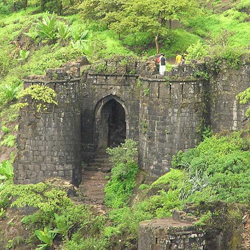
About The Sinhagad Fort The Sinhagad Fort, also known as the Lion's Fort, is a historic fortress located near Pune in Maharashtra, India. Situated atop a hill at an elevation of 1,312 meters above sea level, the fort offers stunning views of the surrounding landscape. The fort has a rich history and has witnessed several significant battles over the years. Timings Of Sinhagad Fort The Sinhagad Fort is open to visitors every day from 9:00 am to 6:00 pm. It is advisable to visit the fort during the daytime to enjoy the panoramic views and explore the historical structures. Entry Fee The entry fee for visiting the Sinhagad Fort is nominal, with a small charge for both Indians and foreign tourists. Additionally, there may be additional charges for parking and camera usage. Required Time And Restricted Items It is recommended to spend at least 3 to 4 hours exploring the Sinhagad Fort to fully appreciate its historical significance and enjoy the scenic beauty. Visitors are advised not to carry plastic items and alcohol to preserve the sanctity of the fort. Architecture Of Sinhagad Fort The architecture of the Sinhagad Fort showcases a blend of Maratha and Mughal styles. The fort houses several structures including bastions, gates, temples, and a memorial dedicated to Tanaji Malusare, a Maratha warrior who sacrificed his life during the Battle of Sinhagad. Best Time To Visit The best time to visit the Sinhagad Fort is during the monsoon season, from June to September, when the surrounding hills are covered with lush greenery and the weather is pleasant. However, the fort can also be visited throughout the year. How To Reach The Sinhagad Fort is located around 30 kilometers southwest of Pune city. Visitors can reach the fort by road via private vehicles, taxis, or state transport buses. The nearest airport is Pune Airport, and the nearest railway station is Pune Junction. History of Sinhagad Fort The Sinhagad Fort has a long and storied history, with its origins dating back to the 17th century. It was initially under the control of the Maratha Empire and later passed into the hands of the British. The fort has witnessed several battles, including the famous Battle of Sinhagad in 1670. Inside Sinhagad Fort Inside the Sinhagad Fort, visitors can explore the various structures such as the Kalyan Darwaza, Tanaji Malusare's memorial, the Kaundinyeshwar Temple, and the remnants of the fortifications. The fort offers breathtaking views of the Sahyadri mountain ranges and the Pune city skyline. Traveling Tips When visiting the Sinhagad Fort, it is advisable to wear comfortable footwear as there is some walking involved. It is also recommended to carry water, snacks, and a camera to capture the stunning views. Visitors should be cautious while climbing the steep steps and should respect the historical significance of the fort. Hotels Near Sinhagad Fort There are several hotels and resorts near the Sinhagad Fort where visitors can stay and relax. Some of the popular options include Hotel Sinhagad Executive, Fort View Resort, and Aura Kalista Resort. These accommodations offer comfortable rooms, delicious food, and excellent services. Nearby Tourist Spots of Sinhagad Fort In addition to the Sinhagad Fort, there are several other tourist spots near Pune that visitors can explore. Some of the popular attractions include Khadakwasla Dam, Panshet Dam, Rajgad Fort, and Torna Fort. These places offer a glimpse into the rich history and natural beauty of the region.
Explore More
About The Pataleshwar Cave in Pune The Pataleshwar Cave is a rock-cut cave temple located in Pune, Maharashtra. It is a popular tourist attraction known for its ancient rock-cut architecture and historical significance. Timings Of Pataleshwar Cave The Pataleshwar Cave is open to visitors from 8:00 AM to 5:30 PM every day of the week. Entry Fee The entry fee for the Pataleshwar Cave is INR 5 for Indian visitors and INR 100 for foreign tourists. Required Time And Restricted Items Visitors typically spend about 1-2 hours exploring the Pataleshwar Cave. Smoking, alcohol, and non-vegetarian food items are not allowed inside the cave premises. Architecture Of Pataleshwar Cave The Pataleshwar Cave is a monolithic rock-cut cave temple dedicated to Lord Shiva. The cave features intricate carvings, sculptures, and a Nandi bull statue. It is believed to have been built in the 8th century during the Rashtrakuta dynasty. Best Time To Visit The best time to visit the Pataleshwar Cave is during the winter months of November to February when the weather is pleasant and ideal for sightseeing. How To Reach The Pataleshwar Cave is located in Jangali Maharaj Road, Pune, and can be easily reached by public transportation such as buses or auto-rickshaws. The nearest railway station is Pune Junction, and the nearest airport is Pune International Airport. History Of Pataleshwar Cave The Pataleshwar Cave is believed to have been built in the 8th century by the Rashtrakuta dynasty. It is dedicated to Lord Pataleshwar, an incarnation of Lord Shiva. The cave has historical significance and is considered an important heritage site in Pune. Inside Pataleshwar Cave Inside the Pataleshwar Cave, visitors can explore the rock-cut temple, sculptures of deities, and inscriptions on the walls. The main sanctum houses a linga (symbol of Shiva) and a Nandi bull statue. The cave also has a courtyard and a water tank. Traveling Tips It is advisable to wear comfortable footwear as visitors need to walk on uneven terrain inside the cave. Carry drinking water and sunscreen as there are limited facilities inside the cave. Photography is allowed but be respectful of religious sentiments while clicking pictures. Hotels Near Pataleshwar Cave With Names Some of the hotels near the Pataleshwar Cave in Pune include: Hotel Shree Panchratna The Orchid Hotel Pune Ibis Pune Hyatt Pune Nearby Tourist Spots Of Pataleshwar Cave There are several other tourist attractions near the Pataleshwar Cave that visitors can explore, including: Shaniwar Wada Dagdusheth Halwai Ganpati Temple Aga Khan Palace Raja Dinkar Kelkar Museum
Explore More
The huge collection of different items from different categories is what makes Raja Dinkar Kelkar Museum a place where you should all visit at least once. From painting to sculptures and even different types of musical instruments can be found here to kill the hunger of history and art inside you. Pune is the city that has seen rapid development and also the changing face of the country. It is the centre of the IT, business, research, automobile, and even education sector. This cosmopolitan city is also has a tinge of ancient times. The city has people who have high quality and standards of living which is depicted by the international restaurants, swanky malls, and other commodities that we see in urban life. Along with all these, it is also a torchbearer of the Marathi culture. Ganesh festival is the best and well-celebrated festival and one must come and experience in here. The beautiful tourist places in Pune are the symbol of great history and it tells its own story. With the time it saw several battles and have endured the rest of the time. Same as other attractions, the Raja Dinkar Kelkar Museum, Pune will take you to a mesmerising journey down the timeline of the history of India. You will be fascinated by the beautiful collection that they have for you. But before you go there are certain things that you need to know about the place. Traveller Tips There are some tips to remember if you are visiting Raja Dinkar Kelkar Museum, Pune. • There are various sections that you will get in the museum that you must visit thoroughly and separately to get a better idea of history and art. • The various departments that are here are as follows: 1. Indian paintings 2. Vanita Kaksha 3. Gujarat gallery 4. Lamps 5. Musical instruments 6. Ivory objects 7. Mastani Mahal 8. Sculpture 9. Tambol Things To Do Visiting Raja Dinkar Kelkar Museum, Pune you can learn about different facts about the Maratha culture and the vast history behind it. All your misconceptions will be cleared once you visit here. People And Language The most widely spoken and the official language of Pune is Marathi. Hindi and English are understood and spoken by people here. There are other people as well who have settled in Pune for earning and educational purposes and they speak their native languages. Pune is home to people who belong to different religions, caste, region and cultures. Despite if the differences in the people here, there is still harmony and peace with each other. The reason behind the diversity is the multinational companies and different industries. Various institutions, colleges, universities have also attracted people from all parts of the county. This city is the ideal place for all the IT sector. Popular Culture Pune is a cosmopolitan city which is considered the cultural capital of the state Maharashtra. This is the city where you can see modern and traditional culture combing. The Ganesh festival is the apt representation of culture. The city is decorated with diyas, lights, flowers and much more for 10 days. Other festivals that are celebrated here with joy and happiness are Christmas, Eid, and New Year. This place is also the city of music, art, theatre, and dance. There is also a world-famous classical music festival celebrated here. There are several platforms and theatres for new actors and actresses. Pune is also a city for foodies. No matter whether you are south Indian, Punjabi or belong from any other part of the country, you will get all kinds of food in Pune. Best Time To Visit Earlier, this city was blessed with mild and pleasant weather throughout the year. But as time went by and the green cover removed due to industrialisation and urbanisation, the summers become hot and humid and even difficult to survive. The winter season is the best time to visit Pune which lasts from Nov to Feb. The weather is pleasant in these months and you can explore the city better. As Raja Dinkar Kelkar Museum, Pune has nothing to do with the weather outside, it can be visited at any time of the year. Thus, you can come and visit the museum at any point of the year when you find it convenient and comfortable. Apart from all Pune is a lovely city that can be visited at any time of year but the specific time is the winter season when you will find the weather at its best. How to Reach? The railways are the best mode for transport as it connects different places. Therefore Pune is easily accessible. After you have reached the station, you can get any cab and visit Raja Dinkar Kelkar Museum, Pune. Cabs are also the easiest method of transportation here. The airports of Pune or Pune airport is just 10 km away from the main city. You can land and take a cab and taxi to the museum. Interesting Facts and Trivia There are some interesting facts about Raja Dinkar Kelkar Museum, Pune about which you must know. Some are: • Dr. Dinkar Kelkar starting a collection in the year 1920 and by 1960. He collected over 15,000 artifacts that are there on display. • Many schools take their students here to enjoy and learn more about history and culture. • The museum shows us the beautiful and amazing history of the Marathas and their amazing culture. Therefore you can clear all you doubt that you get all over the internet by visiting this place. Thus, visit this museum and enjoy your holidays and learn about history and culture. You will feel knowledgeable and also will find yourself in the past.
Explore More
About The Lohagad Fort The Lohagad Fort is a historic hill fort situated near the city of Pune in Maharashtra, India. It is located at an altitude of 3,389 feet above sea level and offers panoramic views of the surrounding valleys and hills. The fort is known for its architectural grandeur and historical significance, making it a popular tourist destination for history buffs and nature lovers alike. Timings Of Lohagad Fort The Lohagad Fort is open to visitors from 9:00 AM to 6:00 PM on all days of the week. Entry Fee There is no entry fee for visiting the Lohagad Fort. Required Time And Restricted Items It takes approximately 2-3 hours to explore the Lohagad Fort completely. Visitors are advised not to carry plastic bottles, alcohol, and non-vegetarian food items inside the fort premises. Architecture Of Lohagad Fort The architecture of Lohagad Fort reflects a blend of Maratha and Mughal styles. The fort consists of several structures including gates, ramparts, and bastions, showcasing the military prowess of the Maratha Empire. Best Time To Visit The best time to visit Lohagad Fort is during the monsoon season (July to September) when the surroundings are lush green and the weather is pleasant. Winter (October to February) is also a good time to visit due to the cool and dry weather. How To Reach Lohagad Fort is easily accessible from Pune by road. Visitors can hire a taxi or drive their own vehicle to reach the base of the fort. From there, a trek of around 1-2 hours leads to the entrance of the fort. History Of Lohagad Fort Lohagad Fort has a rich history dating back to the 18th century when it was under the control of the Maratha Empire. It served as a strategic stronghold for the Marathas and played a crucial role in various battles and conflicts. Inside Lohagad Fort Inside the fort, visitors can explore various structures including the Vinchukata (Scorpion's tail), Hanuman temples, Mahadarwaja (Main entrance), and a large water reservoir. The fort also offers stunning views of the surrounding landscape. Traveling Tips Visitors are advised to wear comfortable clothes and shoes for trekking to the fort. It is recommended to carry drinking water and snacks as there are limited facilities available on the fort premises. Also, do not litter and maintain the cleanliness of the fort. Hotels Near Lohagad Fort Some of the hotels near Lohagad Fort include: 1. The Fern Residency, MIDC 2. Hotel Regency, Lonavala 3. Hotel Sapphire, Lonavala 4. Fariyas Resort, Lonavala 5. Citrus Lonavala Nearby Tourist Spots Of Lohagad Fort Some of the nearby tourist spots of Lohagad Fort include Visapur Fort, Bhaja Caves, Karla Caves, Pawna Lake, and Lion's Point. These places offer additional opportunities for sightseeing and exploring the natural beauty of the region.
Explore More
About The Ausa Ausa is a historical town located in the Latur district of Maharashtra, India. It is known for its ancient fort and rich cultural heritage. The town is home to several temples, mosques, and other historical monuments that attract tourists and history enthusiasts from all over the country. Timings Of Ausa The Ausa town is open for visitors all year round. However, it is recommended to visit during the daytime to fully explore its attractions and enjoy the scenic beauty of the surroundings. Entry Fee There is no entry fee to visit Ausa town. Visitors can freely explore the historical sites, temples, and other attractions without any charges. Required Time And Restricted Items It is recommended to spend at least half a day in Ausa to explore its major attractions fully. Some restricted items include alcohol, weapons, and any items that may disturb the peace and sanctity of the historical sites. Architecture Of Ausa The architecture of Ausa reflects a blend of various styles, including Maratha, Mughal, and Persian influences. The ancient fort, temples, and mosques showcase intricate carvings, domes, and pillars that highlight the craftsmanship of the bygone era. Best Time To Visit The best time to visit Ausa is during the winter months (October to March) when the weather is pleasant and ideal for sightseeing. However, visitors can also explore the town during the monsoon season to witness the lush greenery and enjoy the cool weather. How To Reach Ausa is well-connected by road, rail, and air. The nearest airport is in Latur, approximately 50 kilometers away. Visitors can also reach Ausa by train or bus from major cities like Mumbai, Pune, and Hyderabad. History Of Ausa Ausa has a rich historical significance dating back to the medieval period. It was once ruled by various dynasties, including the Rashtrakutas, Chalukyas, and Bahamanis. The town witnessed several battles and political changes over the centuries, leaving behind a legacy of architectural marvels and cultural heritage. Inside Ausa Inside Ausa, visitors can explore the ancient Ausa Fort, which offers panoramic views of the town and its surroundings. There are also several temples like the Siddheshwar Temple, Vithoba Temple, and Jama Masjid that showcase the religious diversity and cultural richness of the town. Traveling Tips When visiting Ausa, it is advisable to carry sunscreen, hats, and sunglasses to protect yourself from the sun. Additionally, wearing comfortable footwear is recommended as there may be some walking involved while exploring the historical sites. Hotels Near Ausa Some of the hotels near Ausa include: Hotel Marathwada Lodging And Boarding Hotel Shangrila Hotel Center Point Nearby Tourist Spots Of Ausa Some nearby tourist spots near Ausa include: Ganj Golai Udgir Fort Ashtavinayak Temple, Morgaon
Explore More